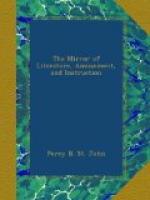One of the most elegant articles of furniture in ancient use was the candelabrum, by which we mean those tall and slender stands which served to support a lamp, but were independent of and unconnected with it. These, in their original and simple form, were probably mere reeds, or straight sticks, fixed upon a foot by peasants, to raise their light to a convenient height; at least, such a theory of their origin is agreeable to what we are told of the rustic manners of the early Romans, and it is in some degree countenanced by the fashion in which many of the ancient candelabra are made. Sometimes the stem is represented as throwing out buds; sometimes it is a stick, the side branches of which have been roughly lopped, leaving projections where they grew; sometimes it is in the likeness of a reed or cane, the stalk being divided into joints. Most of those which have been found in the buried cities are of bronze; some few of iron. In their general plan and appearance there is a great resemblance, though the details of the ornaments admit of infinite variety. All stand on three feet, usually griffins’, or lions’ claws, which support a light shaft, plain or fluted according to the fancy of the maker. The whole supports either a plinth large enough for a lamp to stand on, or a socket to receive a wax-candle, which the Romans used sometimes instead of oil in lighting their rooms. Some of them have a sliding shaft, like that of a music-stand, by which the light might be raised or lowered at pleasure.
We may here say a few words on the art of inlaying one metal with another, in which, as in all ornamental branches of the working of metals, the ancient Italians possessed great skill. In the time of Seneca, ornaments of silver were seldom seen, unless their price was enhanced by being inlaid with solid gold. The art of uniting one metal to another was called by the general term ferruminare. Inlaid work was of two sorts; in the one, the inlaid work projected above the surface, and was called emblemata, as the art itself was called, from the Greek, embletice. It is inferred, from the inspection of numerous embossed vases in the Neapolitan Museum, that this embossed work was formed, either by plating with a thin leaf of metal figures already raised upon the surface of the article, or by letting the solid figures into the substance of the vessel, and finishing them with delicate tools after they were attached. In the second sort, the inlaid work was even with the surface, and was called crusta, and the art was called, from the Greek, empaestice. This is the same as the damask work so fashionable in the armour of the fifteenth and sixteenth centuries, which is often seen beautifully inlaid with gold. It was executed by engraving the pattern upon the surface of the metal, and filling up the lines with fine plates of a different metal; the two were then united with the assistance of heat, and the whole burnished. Pliny has preserved a receipt for solder, which probably was used in these works. It is called santerna; and the principal ingredients are borax, nitre, and copperas, pounded, with a small quantity of gold and silver, in a copper mortar.




